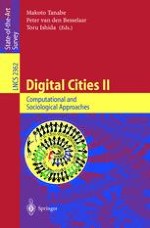2002 | Buch
Digital Cities II: Computational and Sociological Approaches
Second Kyoto Workshop on Digital Cities Kyoto, Japan, October 18–20, 2001 Revised Papers
herausgegeben von: Makoto Tanabe, Peter van den Besselaar, Toru Ishida
Verlag: Springer Berlin Heidelberg
Buchreihe : Lecture Notes in Computer Science
Enthalten in: Professional Book Archive
